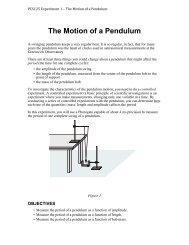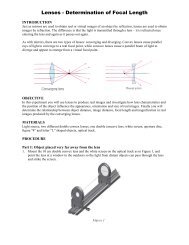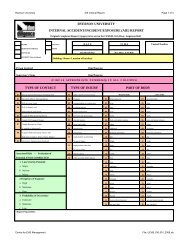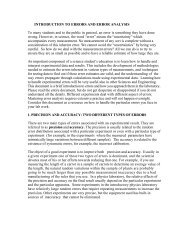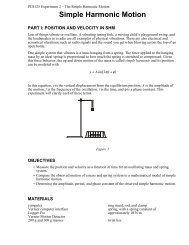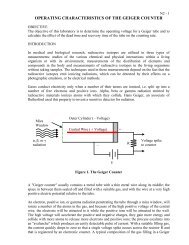DISPERSION OF A GLASS PRISM - Ryerson Department of Physics
DISPERSION OF A GLASS PRISM - Ryerson Department of Physics
DISPERSION OF A GLASS PRISM - Ryerson Department of Physics
- No tags were found...
You also want an ePaper? Increase the reach of your titles
YUMPU automatically turns print PDFs into web optimized ePapers that Google loves.
PH2 – page 6↑Closest to perfect alignmentFigure 7: Vernier reading, Example 2Main scale divides one complete revolution into 360 0 and the vernier has 10 divisions. Thevernier line closest to perfect alignment with the main scale line reads 0.8PROCEDURE: MEASURING THE ANGLE <strong>OF</strong> MINIMUM DEVIATION1. Place the light source a few centimeters behind the slit <strong>of</strong> the collimator.2. Once you have aligned and focused the spectrometer as described earlier, place the prism on thespectrometer table so that the incident light passes through it. It may be helpful to partiallydarken the room.3. It is generally possible to see the refracted light with the naked eye. Locate the general directionto which the light is refracted, and then align the telescope and spectrometer table base so the slitimage can be viewed through the telescope.4. While looking through the telescope, rotate the spectrometer table slightly back and forth. Noticethat the angle <strong>of</strong> refraction for the spectral line under observation changes. Rotate thespectrometer table until this angle is a minimum, and then rotate the telescope to align thevertical cross-hair with the fixed edge <strong>of</strong> the slit image as in Figure 8 below. Use the fine adjustknobs to make these adjustments as precisely as possible, then measure the telescope angle θ minusing the vernier scale.Slit ImageVertical Cross-HairFigure 8: View through the telescope




